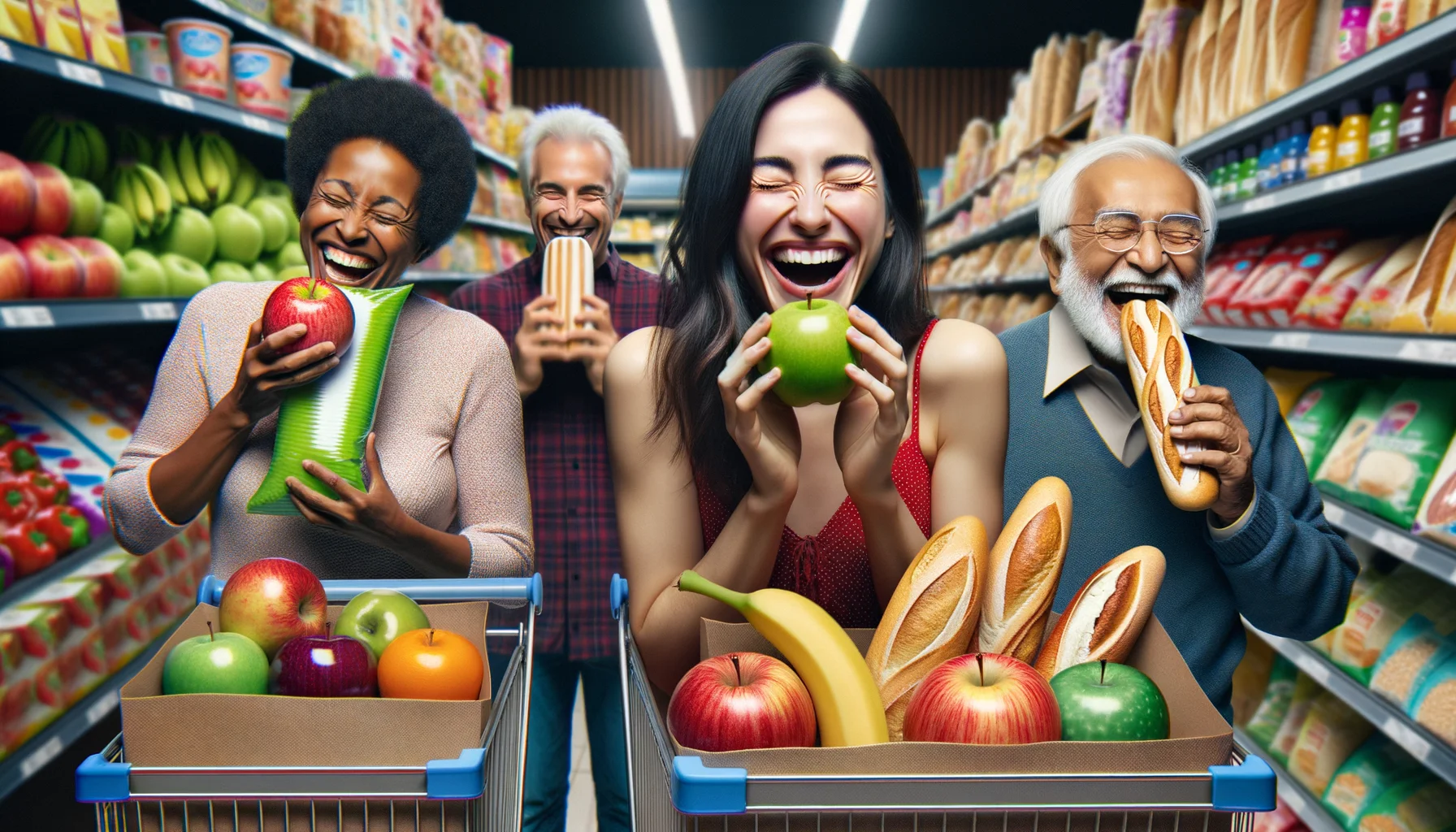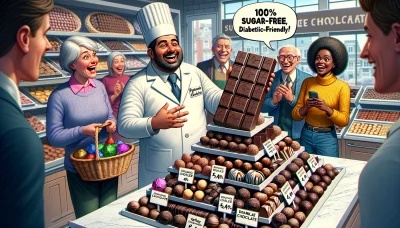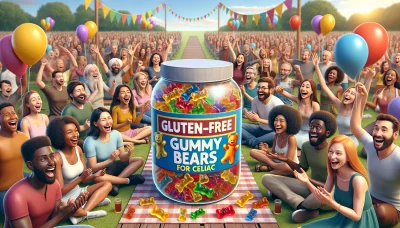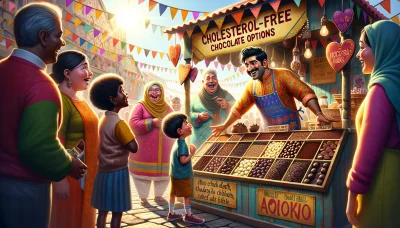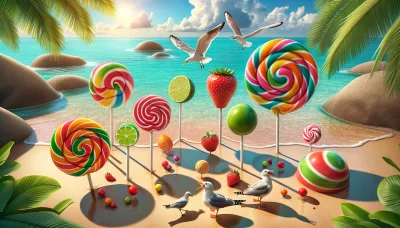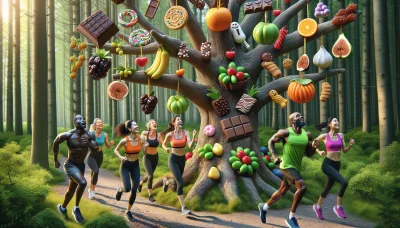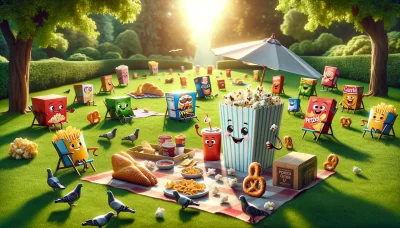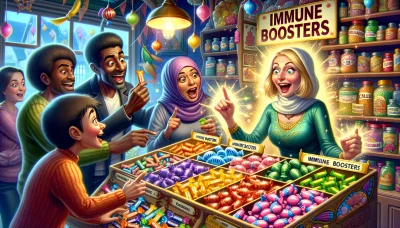Eco-Friendly Edible Packaging Solutions Quiz
Test Your Knowledge
Question of
Understanding Eco-Friendly Edible Packaging
Definition and Importance
Have you ever taken a bite of a fresh apple and wished you could just keep going, crunching right through the packaging without a second thought? Well, the universe has heard our collective sighs for convenience and sustainability and answered with edible packaging. It's not just about reducing waste; it's a little nod to the child in us that gets a thrill out of the unconventional. The concept of edible packaging is simple yet revolutionary: it's a type of wrapping or container made from substances that are safe (and sometimes delicious!) to eat.
When I ponder the importance of sustainability in packaging, I can't help but feel a surge of hope. It's like we're finally waking up to Mother Natures morning calls. Every time we choose an eco-friendly option, we're casting a vote for the kind of world we want to live in. Sustainability isn't just a buzzword; it's our ticket to a cleaner planet, where waste is not an overlooked byproduct but an opportunity for innovation.
Edible packaging whispers promises of guilt-free indulgence into our ears. Imagine savoring your favorite snack and knowing that its wrapper can either be eaten or will biodegrade swiftly and harmlessly. It's like giving Earth a gentle pat on the back rather than leaving it with the mess to clean up after our picnic.
Types of Edible Packaging Materials
My first encounter with edible packaging was almost serendipitous - I didn't realize my desserts wrapper was plant-based until I read the tiny print on the menu. The material felt like rice paper but had this subtle sweetness that complemented my treat perfectly. Plant-based options have sprouted up all over, made from seaweed, starches, and even fruit pulps. They're not just containers; they're part of the culinary experience.
Then there are animal-based alternatives, which might sound odd at first blush. But think about it: cheese wax has been around since who-knows-when, protecting our beloved wheels of Gouda and Brie without us batting an eye at nibbling some wax along with our cheese. Gelatin films have also entered the scene, offering their strength and flexibility to encapsulate anything from vitamins to olive oil.
- Seaweed Wraps: These make sushi rolls look like theyre wearing little green coats.
- Cornstarch Packages: Theyre so versatile, they could run for office.
- Fruit Leather Pouches: They hug your snacks with a tangy embrace.
- Gelatin Capsules: Tiny transparent submarines keeping your supplements dry.
- Milk Protein Films: Dont worry, they dont spoil like milk; theyre too busy being eco-warriors.
Benefits of Switching to Edible Packaging
There's a certain kind of magic in unwrapping a treat, the anticipation that builds as layers peel away. But what if the packaging itself could be part of the delight? Imagine a world where the wrapper, just like the confection it cradles, melts in your mouth, infusing your senses with an extra burst of flavor. This enchanting scenario is no longer relegated to the realms of fantasyedible packaging solutions are here, and they're transforming our snacking experience while championing eco-friendly principles.
The shift toward edible packaging is more than a novel idea; it's a step towards sustainability that resonates with my own journey to live more harmoniously with nature. Every time I choose an edible packaged good, I feel empowered knowing I'm reducing my environmental footprintone delicious bite at a time. The sheer joy of indulging in these treats without the guilt of waste is like finding an unexpected oasis in a desert of plastic.
But let's not sugarcoat it; we've all experienced that moment of dismay when confronted with the excessive plastic that swathes so much of our food. It's a sticky situation, but edible packaging offers a sweet escape. Its an inspiring example of how our everyday choices can pave the way for a greener future, and its these small but mighty acts that add up to create significant change.
Environmental Advantages
When I first stumbled upon edible packaging, it was like witnessing a small revolution in my pantry. The reduction in plastic waste was palpable. No longer did I have to wrestle with the guilt-ridden task of discarding swathes of plastic into the bina bin that symbolized the larger issue looming over our planet's health.
Each edible wrapper I consumed felt like casting a vote for Mother Earth, contributing to a movement that could eventually see our landfills less choked with waste. It's been said that we don't inherit the earth from our ancestors; we borrow it from our children. In this light, edible packaging isn't just eco-friendly; it's an act of intergenerational kindness.
And then there's the matter of carbon footprintthe invisible yet heavy boots we all leave on Earths soil. Traditional packaging materials take arduous journeys from production to disposal, emitting greenhouse gases every step of the way. Edible packaging solutions tend to have lower carbon footprints since they are often produced from natural and renewable sources. They are gentle whispers compared to traditional packagings heavy tread.
Reduction in Plastic Waste
The numbers speak louder than words: billions of tons of plastic waste are generated yearly, and only a fraction is recycled effectively. Edible packaging nibbles away at this overwhelming statistic by offering an endearing alternative: eat rather than discard.
Just imagine attending a sports event or music festival where snacks come wrapped in edible casingspicture the grounds post-event, remarkably devoid of the usual littered landscape. Its not just wishful thinking; its an achievable reality with edible packaging solutions leading the charge against plastic pollution.
We're not there yet, but each bite-sized action counts. With every snack encased in this innovative material, we're slowly chipping away at mountains of waste, replacing them with sustainable practices that resonate with natures cycles.
Lower Carbon Footprint
- Reduced Transportation Emissions: Because many edible packages are made from locally sourced ingredients, their journey from farm to tableand ultimately into our belliesis significantly shorter.
- Energy-Efficient Production: Often requiring less energy to produce than conventional plastics, these biodegradable alternatives leave behind only delectable memories instead of harmful emissions.
- Compostability: For those few remnants that might not be consumed (perhaps due to personal taste or dietary restrictions), many edible packages can be composted, contributing positively to nutrient cycles rather than languishing in landfills.
Health and Safety Considerations
Beyond their environmental credentials, edible packages offer peace of mind when it comes to health and safetyafter all, theyre designed for consumption! Made from non-toxic materials such as natural starches and seaweed extracts, these wrappers assure us that we aren't ingesting anything nefarious with our nourishment.
As someone who values knowing what goes into my body as much as what goes into my environment, this transparency is deeply reassuring. There's no deciphering cryptic ingredient lists or fretting over synthetic substancesit's all about pure and simple enjoyment without compromise.
Additionally, recognizing that food sensitivities are as varied as tastes themselves, there are allergen- and gluten-free options emerging within this budding industry. This inclusivity means more people can join in on this gustatory journey towards sustainability without hesitation or concernit's an open invitation to partake in both flavor and responsibility.
Innovations in Edible Packaging Technology
Oh, the joy of nibbling on a sweet little morsel and realizing that there's no wrapper to discard, no trace left behind but the lingering flavor on your tongue. This is the magic woven by innovations in edible packaging technology. It feels like a secret handshake with Mother Earth, a pact to indulge without leaving footprints. Each bite, enveloped in its own savory or sweet coating, whispers the future of sustainability.
But let's not just talk about the delight of eating your packaging; let's dive into the sheer genius of it. Imagine a world where we can have our cake and eat the wrapper too! That's not just some whimsical fantasy; it's becoming a reality thanks to some brilliant minds turning science fiction into science fact. Its not just about reducing waste; its about transforming our relationship with food and packaging altogether.
From the zesty tang of citrus peels morphed into bottles to milk proteins fashioned into film wraps that melt in your mouth, these solutions are as varied as they are vanguard. It's like a culinary ballet where form meets function, and both are devoured in applause an encore for eco-consciousness.
Latest Developments in the Industry
It feels like every day there's a new headliner in the world of edible packaging. The latest developments have us at the edge of our seats or should I say, dinner tables? Companies are now creating everything from seaweed-based water pods to tomato-derived boxes that you can toss into a stir-fry after delivery. Its like our meals come dressed for a masquerade ball, and when they reveal themselves, we find theyre made entirely out of food!
The industry isn't just stopping at functionality; its putting on its top hat and aiming for sophistication. Imagine sipping your morning coffee from a cookie cup coated with sugar icing each sip is accompanied by the anticipation of an edible treat waiting patiently for you to finish. Its as if your cup is cheering you on: Go ahead, take another sip, Im here for you!
- Cutting-Edge Biodegradable Solutions
- Advances in Preservation and Durability
Cutting-Edge Biodegradable Solutions
The term 'cutting-edge' might conjure images of gleaming metal, but here it's all about sophisticated organics melting away without a trace. We're talking about biodegradable solutions so advanced they make composting look like child's play. There are films made from pectin that wrap around your sandwich like a protective hug from nature and when youre done, they return to the earth as if waving goodbye after a job well done.
Advances in Preservation and Durability
Preservation used to mean layers upon layers of materials that would outlive us all. But now durability doesnt have to compromise delectability or disposability. There are now wrappers infused with natural preservatives that keep your snacks fresh and then gracefully bow out, decomposing like autumn leaves returning to soil. Theyre like little food guardians that ensure every morsel is savored before taking their final curtain call.
Future Trends and Predictions
The crystal ball of edible packaging shows a future so bright you might want to eat it literally! Analysts predict growth in this market that could rival the most popular tech startups. We're looking at an industry ready to burst forth like popcorn kernels in hot oil each pop another innovation joining the ranks.
Someday soon we might walk down grocery aisles bewildered by choices not just of flavors but of edible containers: "Do I feel like almond today or perhaps rosemary-infused?" The potential for new material discoveries is akin to alchemy; who knew that mushrooms could be coaxed into vessels sturdy enough for shipping? Its as if fungi had been waiting all this time to reveal their true potential as packaging prodigies.
Growth of the Edible Packaging Market
The growth trajectory for this market seems almost as tasty as the products it protects. With consumers clamoring for sustainable options and companies seeking innovative branding opportunities, edible packaging becomes more than just a niche its becoming mainstream haute cuisine for environmentally savvy shoppers.
Potential for New Material Discoveries
The hunt for new materials has scientists playing with their food in ways we never imagined. From chocolate foil that dissolves on your tongue to spicy rice paper wrappers adding an extra kick to burritos who knows what will be next? This isnt just packaging; its an invitation to explore flavors and textures that turn snacking into an adventure.
How to Choose the Right Edible Packaging
Have you ever unwrapped a treat, only to be left staring at the remains of what seems like an unnecessary environmental faux pas? Well, imagine a world where every morsel of packaging could simply be eaten along with the product it protects. This isn't a far-off fantasy; it's the burgeoning realm of edible packaging. It's a delightful dance between sustainability and indulgence, where choosing the right packaging is akin to selecting the perfect topping for your favorite ice cream.
But how do we navigate this new territory? Selecting the right edible packaging is not merely about tasteit's an art that requires consideration of quality, effectiveness, and the sheer joy that comes from knowing you're doing right by Mother Earth. Let's embark on this flavorful journey together, shall we?
Assessing Quality and Effectiveness
When you're standing in front of shelves lined with products ensconced in their edible attire, don't just get swayed by the glossy finishes or vibrant colors. Assessing their quality is about peeling back the layers (figuratively, of course) to ensure they meet your standards. You want packaging that not only looks good but also does its job with flair.
The effectiveness of these innovative solutions lies in their ability to shield our beloved snacks from the harshness of their environment. Will your chocolate bar draped in a sugary sheath withstand a sunny day out? Does the film around your cheese keep it as fresh as morning dew? These are questions we must ponder with each potential purchase.
Evaluating Material Safety and Compliance
Now, let's talk safetybecause nobody wants a side of risk with their rice cake. The materials used in edible packaging must be scrutinized like a detective examining clues. They should be free from harmful substances and compliant with food safety regulations because while innovation is delicious, well-being is non-negotiable.
With each layer of biodegradable brilliance we consider, it's essential to check for certifications and safety marks. It's not just about whether you can eat it; it's about whether you should. After all, were here for a good time and a long time.
Testing for Shelf-Life and Stability
Akin to finding a soulmate, testing for shelf-life and stability in edible packaging is about commitment. Will this material stand by your snack through thick and thin? The longevity of these eco-friendly alternatives often hinges on rigorous testingsubjected to various climates and conditionsto ensure they hold up just as well as their less-environmentally friendly counterparts.
- Durability under different temperatures
- Resistance to moisture and air exposure
- Protection against contaminants
- Aesthetics preservation over time
Cost-Benefit Analysis
As we meander through this delectable landscape of eco-conscious choices, our wallets whisper words of caution. Edible packaging may seem like an extravagant choice at first glancebut let us delve deeper into the economics of eating our way to a cleaner planet.
Investing in these tasty wrappers is not merely a purchase; it's planting seeds for future harvests. The idea is to weigh immediate costs against long-term environmental savingsbecause who doesn't love saving green in more ways than one?
Understanding Pricing Structures
Peering at price tags can sometimes feel like decoding ancient hieroglyphs. However, understanding pricing structures for edible packaging solutions need not require an archaeology degree. Prices often reflect not just production costs but also the innovation and research poured into making these items both palatable and protective.
Implementation Strategies for Businesses
Transitioning from Traditional to Edible Packaging
The moment when you unwrap a candy bar, the scent of chocolate wafting up to greet you, is pure delight. But then, there's the wrapper, that piece of plastic that serves its purpose for a mere moment before it's discarded, destined for a landfill or the ocean. Imagine if that wrapper could be part of the experience, an extension of the treat itself, not just in spirit but in substance. That's where edible packaging comes in, transforming every bite into an act of environmental stewardship.
Transitioning to edible packaging isn't just about swapping materials; it's about embracing a new philosophy. It's a journey from the conventional to the innovative, from waste to taste. As businesses ponder over this shift, they're not just changing their product; they're altering their narrative, telling a story that resonates with the eco-conscious epicurean in all of us.
Step-by-Step Guide for Businesses
The first step is often laced with trepidationthe unknowns are as vast as the potential rewards. But businesses must start by dipping their toes into the pool of possibilities. Research is paramount; understanding what edible packaging materials are available and compatible with your products is like choosing the right wine to complement your mealit must enhance, not detract from, the overall experience.
Next comes testingbecause even the most exquisite chocolate truffle would frown upon being dressed in an ill-fitting coat. It's about finding that balance between practicality and palatability. And once you've found your match, education and marketing follow. Your customers need to know why this change is not just good but sensational for them and for Mother Earth.
Overcoming Common Challenges
Its like hosting a dinner party where some guests are hesitant about trying your avant-garde dish. There will be challengescost implications, shelf life considerations, regulatory compliancesthat make switching to edible packaging seem daunting at first glance. But these challenges are but spices in your business kitchen; they enhance your commitment to innovation and sustainability.
Addressing these concerns head-on with transparency can turn skeptics into advocates. Cost can be mitigated by economies of scale or by positioning products as premium offerings. Shelf life can be extended through ingenious combinations of natural preservatives and clever design. Compliance becomes easier as regulations evolve to support sustainable initiatives.
Case Studies: Success Stories and Lessons Learned
Analysis of Successful Implementations
There are whispers in the market about those who've already taken the plungethe trailblazers who wrap their gourmet nuts in seaweed-based films or serve coffee in cups you can eat afterward like a biscuit. These stories aren't just inspiring; they're instructional blueprints for those ready to follow suit.
Analyzing these cases reveals patterns: successful businesses often start small with limited edition releases or pilot programs that allow them to gauge consumer response and refine their approacha strategy akin to sprinkling just a pinch of salt rather than pouring it all at once.
Adaptation Strategies from Industry Leaders
- Engage Your Audience: Like any good storyteller knows, engagement is key. Industry leaders didnt just change their packaging; they invited their customers on a journey.
- Innovate Continuously: They treat their packaging solutions like recipes that can always be improved upona pinch more of this or a dash less of that.
- Collaborate: Partnerships with other forward-thinking companies or research institutions have proven beneficialafter all, two chefs are better than one.
- Sustainability Branding: Theyve woven sustainability into their brand identity as intricately as saffron threads in a risotto.
By observing how industry leaders adapt and thrive with edible packaging solutions, we gather not only inspiration but also practical methods for our own ventures into this sustainable frontiera place where every bite is guilt-free and every wrapper is a whisper of change.
Consumer Perception and Acceptance
There's something about the anticipation of unwrapping a treat, the crinkle of the packaging that sets your senses on edge, ready for the delight to come. But what if that crinkly nuisance could join in the dance of flavors? That's where eco-friendly edible packaging solutions pirouette onto the stage, twirling with potential and promise. As someone who deeply cares about our planet's health and is always on the lookout for ways to indulge responsibly, I've watched with a keen eye as these innovative solutions have begun to reshape consumer perceptions.
The concept might seem plucked from a futuristic film, but it's as real as the last chocolate bar you savored. Think about it a wrapper you can eat as part of your snack! Its an idea that tickles the imagination and tempts the taste buds. But beyond its novelty, it whispers a tale of empowerment and sustainability, urging us to take control of our environmental footprint with every bite we take. The journey of acceptance is as rich and complex as a finely crafted confectionery, layered with curiosity, skepticism, and ultimately, delight in discovery.
Educating the Public on Edible Packaging Benefits
Now, I must admit that when I first heard about edible packaging, my eyebrows arched in intrigue. Could this be another chapter in our love affair with convenience or perhaps a step towards mending our fractured relationship with Mother Earth? To bring this vision to life, educating the public is like crafting a recipe that needs just the right balance of information and inspiration. Information campaigns have been sprinkling knowledge like sugar dust across social platforms, cooking up interest in these eco-friendly alternatives.
Awareness efforts are akin to sowing seeds in fertile soil they need nurturing to grow. Demonstrating practical use and convenience is like giving someone their first taste of chocolate once they've experienced it, there's no turning back. Picture yourself at a picnic, enjoying sandwiches without unpacking them or sipping on a drink encased in a flavorful shell. The ease intertwines with environmental consciousness seamlessly, creating an experience both gratifying and guilt-free.
Feedback and Consumer Insights
- Gathering Consumer Opinions and Preferences
- Leveraging Positive Feedback for Brand Growth
The true measure of any edible innovation lies within the chorus of voices that sing its praise or whisper its shortcomings. Gathering consumer opinions is like holding a tasting event where every comment card is a nugget of pure gold. With each piece of feedback comes an opportunity to refine the recipe to enhance textures that melt in your mouth or flavors that burst like fireworks against your palate.
And then there's leveraging positive feedback for brand growth oh! It's akin to watching dough rise in warm sunlight. Each testimonial is yeast that leavens brand reputation; each shared experience on social media folds into layers of consumer trust. When someone raves about edible packaging being as delightful as their favorite candy bar well, that's when you know you're baking up success.
Regulatory Considerations and Compliance
When I first dipped my toes into the world of eco-friendly edible packaging solutions, it felt like stepping into a verdant garden of innovation. But before one can freely frolic in this green expanse, there's a trellis of regulatory considerations and compliance that must be navigated with the care of a gardener tending to their most prized heirloom tomatoes. It's not just about crafting an edible wrapper that sings to the palate it's about ensuring it hums in tune with food safety standards and dances gracefully through the maze of regulations.
Understanding Food Safety Standards
Imagine biting into a succulent piece of fruit, its natural packaging an extension of its wholesome goodness. That's the dream behind edible packaging. However, ensuring that these innovative containers are as safe as they are scrumptious requires adherence to stringent food safety standards. National and international bodies have set these benchmarks high, like a culinary bar over which each morsel of edible packaging must leap.
National and International Regulations
The global tapestry of food safety regulations is as intricate as a lattice pie crust. Each country serves up its own recipe for regulatory compliancesome with a pinch more rigor, others with a dash of leniency. International guidelines offer a medley of best practices, hoping to harmonize the flavors of national legislation into a delectable symphony that ensures every bite is safenot just on paper but in practice.
Certification Processes for Edible Packaging
To don the mantle of 'certified', edible packaging must endure trials that would make even the heartiest sourdough starter quiver. The certification process is akin to proving oneself worthy at a knightly tournament, but instead of jousting with lances, it's battling through lab tests and audits. Only then can one emerge victorious, carrying the banner of certificationa heraldic symbol that proclaims 'this packaging is fit for your feast'.
- Compliance with Materials: Ensuring all materials used are permissible for contact with food.
- Traceability: Being able to track and trace the journey from ingredient to end-product.
- Labeling Requirements: Accurate labeling that informs and assures consumers about what they're consuming.
Intellectual Property and Patent Landscape
The world of edible packaging isn't just about nurturing natureit's also about cultivating creativity. Intellectual property rights stand guard like scarecrows in a field of innovation, protecting those ingenious ideas from being pecked away by unscrupulous crows. Patents are the seeds from which new growth sprouts, ensuring that today's quirky idea can blossom into tomorrow's ecological revolution.
Protecting Innovations in Edible Packaging
To plant your flag in this fertile ground and declare, "This ingenious contrivance is mine!" you must weave through the thicket of intellectual property law. Protecting innovations ensures that your labor bears fruitfruit wrapped in your very own brand of edible packagingand secures your place at the banquet table of environmental pioneers. Its not just about claiming territory; its about nurturing an ecosystem where creativity thrives alongside sustainability.
Navigating Patent Applications and Rights
The path to securing a patent is as twisted as a cinnamon stick but far less sweet. One must chart this course with precisiona misstep could see your patent caught in the brambles, leaving your invention exposed. Navigating patent applications requires both legal savvy and strategic foresight; it demands understanding not only what has been done before but also what could bethe map to uncharted territories in sustainable gastronomy.
Future of Food Packaging and Sustainability Goals
When I think about the future of food packaging, my heart swells with hope. The idea that one day, we might live in a world where every bite we take comes with a conscience as clean as the plates we're eating off is nothing short of inspiring. Edible packaging isn't just a trend; it's a movement towards a more sustainable planet, aligning seamlessly with the Sustainable Development Goals (SDGs). Imagine wrapping your sandwich in a deliciously thin sheet made from rice or seaweed, knowing that your lunchtime routine contributes to the health of our oceans and forests. It's a small choice that resonates with the global environmental objectives, and it tastes like progress progress that doesn't just disappear but rather dissolves, quite literally, in your mouth.
And then there's the contribution to zero-waste initiatives. Every time you indulge in an edible package, you're not just nourishing your body; you're also nurturing the environment. That leftover wrapper? It doesn't exist. It's part of your meal now, leaving behind nothing but satisfaction and a smile. This is what it means to eat responsibly not just for yourself but for the planet. The flavors are rich, the textures are intriguing, and the emotions? Oh, they're as sweet as the concept itself.
Integrating Edible Packaging into Sustainable Development Goals (SDGs)
The sensation of biting into an eco-friendly wrapper is like no other it's a taste of innovation and care woven into one seamless experience. Aligning with global environmental objectives has never been more delicious. By choosing edible packaging solutions, we become active participants in reducing pollution and conserving resources. It feels empowering to be part of such an important shift in consumer behavior, where every crunch and every munch takes us closer to meeting those lofty SDGs.
Edible packaging also presents an opportunity to contribute to zero-waste initiatives actively. There's something profoundly satisfying about finishing a meal and realizing that there's absolutely nothing left to throw away. The impact is tangible; you can feel it with every fiber of your being from the tip of your tongue to the core of your eco-conscious soul.
Collaborations and Partnerships for a Greener Future
The journey towards sustainability is one best traveled together, which is why engaging with NGOs and government bodies feels like joining hands with kindred spirits who share our vision for a greener future. These collaborations bring together bright minds and passionate hearts, all beating to the rhythm of change. It's like being part of an orchestra where each instrument plays its part in harmony creating music that can heal our planet.
Moreover, building alliances with like-minded companies amplifies our ability to make a difference. There's strength in numbers; when we unite with others whose products whisper sweet nothings to Mother Earth rather than shout insults at her, we create a chorus so powerful it can't be ignored. Picture walking down an aisle at the grocery store where every shelf is filled with responsible choices that tickle your taste buds without poking at your conscience this is what these alliances aim to achieve.
- Empowering Communities: By working together, businesses and organizations can empower local communities by providing sustainable options that support livelihoods and protect natural resources.
- Innovation Drives Change: Partnerships often lead to innovative solutions that may not have been possible independently pushing boundaries and redefining what's possible in edible packaging technologies.
- Educational Outreach: Collaborative efforts often include educational components that help spread awareness about sustainable practices and encourage more people to make eco-friendly choices.
